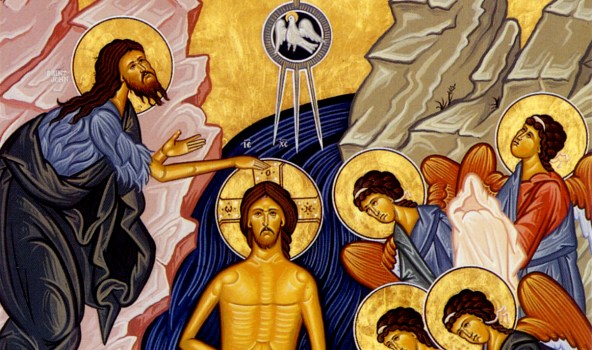Happy Feast Day everyone!
Christ is baptized in the Jordan!
And we with Him!
At the completion of the twelve-day festival, starting on December 25, and ending on January 5, known as Christmastide or the twelve days of Christmas, (although some Christian cultures, especially those of Latin America and some in Europe extend it to as many as forty days, ending on Candlemas – February 2).
It goes by other names in various church traditions. In Hispanic and Latin culture, as well as some places in Europe, it is known as Three Kings’ Day (Span: el Dia de los Tres Reyes, la Fiesta de Reyes, or el Dia de los Reyes Magos; Dutch: Driekoningendag). Originally, there was just one Christian feast of the shining forth of God to the world in the human form of Jesus of Nazareth. It included the celebration of Christ’s birth, the adoration of the Wisemen, and all of the childhood events of Christ such as his circumcision and presentation to the temple as well as his baptism by John in the Jordan. There seems to be little doubt that this feast, like Pascha and Pentecost, was understood as the fulfillment of a previous Jewish festival, in this case the Feast of Lights.
In the Orthodox Church, this observance commemorates Christ’s baptism by John the Forerunner in the River Jordan, and the beginning of Christ’s earthly ministry. The Feast of Theophany is the culmination of the Christmas Season, which starts on December 25 and ends on January 6. In mystic commemoration of this event, the Great Blessing of Water is performed on this day, and the holy water so blessed is used by the local priest to bless the homes of the faithful.
Epiphany
This feast is also sometimes referred to as Epiphany by English-speaking Orthodox Christians, but that name more properly refers to the Western Christian feast falling on that same day and commemorating the visit of the Magi to the child Jesus. The term “Epiphany” does appear in the services for this feast, however.
Celebration of the feast
The services of Theophany are set up exactly as those of the Nativity. Historically the Christmas services were established later.
The Royal Hours are read and the Divine Liturgy of St. Basil the Great is served with Vespers on the eve of the feast. The Vigil is made up of Great Compline and Matins
The Liturgy of the feast begins with psalms of glorification and praise instead of the three normal Antiphons. And the baptismal line from Galatians 3:27 once again replaces the Thrice-Holy.
For as many as been baptized into Christ, have put on Christ! Alleluia!
The Gospel readings of all the services tell of the Lord’s baptism by John in the Jordan River. The epistle reading of the Divine Liturgy tells of the consequences of the Lord’s appearing which is the divine epiphany.
Since the main feature of the feast is the blessing of water. It is prescribed to follow both the Divine Liturgy of the eve of the feast and the Divine Liturgy of the day itself. But most local parishes do it only once when most of the parishioners can be present. The blessing verifies that mankind, and all of creation, were created to be filled with the sanctifying presence of God.
On the Feast of Theophany itself, the priest, wearing white vestments, will celebrate the Great Blessing of Waters, and in some regions frankincense, gold, and chalk.
The blessed chalk is used to write the initials of the three magi over the doors of churches and homes.
Not only do the letters stand for the initials of the Magi (traditionally named Caspar, Melchior, and Balthasar), but of the phrase Christus mansionem benedicat, which translates as
“may Christ bless the house.”
In Alaska, candles are used instead to mark the threshold of every doorway with the sign of the cross.
May Christ bless your home during this holy season, and on this glorious day!

